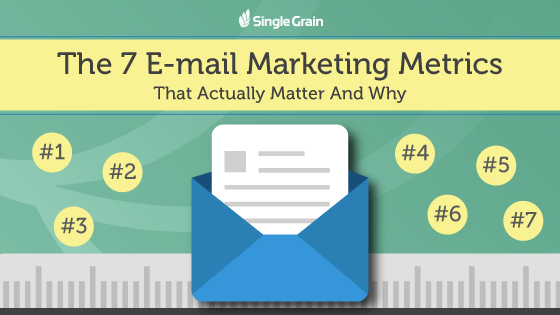
With social media being the most popular kid in school, e-mail marketing has been relegated to the kid sitting alone at the lunch table. E-mail marketing has long been a staple of many businesses, e-commerce and otherwise, and though it doesn’t get as much attention as blogs and articles, it’s still an important part of online marketing.
E-mail marketing can expand your client list and help increase the loyalty with those on it, potentially leading to stronger client relationships and an increase in sales. Like many other types of marketing, however, it comes with a ton of metrics attached.
When looking at the numbers on a campaign, it can be difficult to sort through open rates, click through rates, page visits, and dozens of other metrics that mail delivery software makes available.
All that excess information can make it hard to hone in on the metrics that actually matter in order to successfully evaluate your campaigns and create stronger campaigns in the future.
In this post, we’re going to take a look at the importance of e-mail marketing and tracking your campaigns’ success, the metrics that don’t matter, the 7 e-mail marketing metrics that actually matter—and why.
The Importance of E-mail Marketing
Social media marketing gets a lot of the hype today, but a strong e-mail list with successful campaigns do more than just provide high-value custom audiences for Facebook.
E-mail marketing can help keep you and your business at the forefront of your customers’ minds. Having your content delivered right into customers’ (or potential customers’) inboxes feels more personal, allowing you to more successfully nurture leads in a customized manner.
To reinforce the importance of e-mail marketing, let’s look at some statistics and numbers:
- E-mail marketing yields an average 4,300% ROI for businesses in the U.S.
- Small business owners estimate that spending an extra hour a day doing e-mail marketing is worth $273 an hour
- E-mail marketing is an average of 40% more effective at gaining new customers than both Facebook and Twitter
- Automated e-mail messages average 70.5% higher open rates and 152% higher click through rates than “business as usual” marketing messages
These stats remind us that e-mail marketing does matter and is highly effective, both at generating sales and nurturing leads.
As with any type of marketing effort, it’s important to monitor your campaigns as they progress, and for that, you need to know which metrics matter, and which don’t. So…
Which Metrics Don’t Matter?
While all metrics can offer some insight into your campaigns (and some matter more for different types of campaigns or when addressing different problems), there are some that aren’t quite as effective when measuring the overall success of your campaigns.
These metrics include:
- Open rates. One of the first things that most marketers look at is the open rate. The open rate can tell you a few things, including how good your subject lines and offer are, but overall it’s an unreliable metric. Most mail delivery software won’t register an e-mail as being opened by a user unless the images in it are loaded. Because of this, it’s not a metric that needs to be focused on.
- Churn rate. The churn rate automatically determines how your e-mail list is growing or shrinking; it evaluates the number of subscribers by adding new subscriptions and subtracting unsubscribes. While this can be a helpful metric at first site, some software solutions won’t show you which campaigns lost you subscribers, making it hard to determine why. With the why being so important to improve campaigns for the long term, it’s not much help outside of offering a number.
Keep in mind that all metrics can be valuable in the right light, and can tell you something about your campaigns. A weak open rate, for example, while unreliable, could also point to weak subject lines. If you’re having a specific problem, take a look at the metrics that would most clearly indicate what the problem could be.
When it comes down to it, though, there are several metrics that are more reliable and valuable when evaluating the success and ROI of your e-mail campaigns.
Which Metrics Do Matter
Now that we’ve taken a look at some of the metrics that don’t matter as much and aren’t necessarily crucial to evaluate for most campaigns, we can focus on the metrics that do matter for e-mail marketing.
There are 7 metrics on our list that are most important when measuring the success of your marketing campaigns, which can help you to increase sales, ROI, and have more actions taken on future campaigns.
1. Click-through Rate
The click-through rate is something that plenty of businesses and marketers are familiar with across multiple platforms. It’s a metric that matters when appraising the success of your e-mail (or any) campaigns.
Your click-through rate will tell you how many people have clicked on the link to your landing page per e-mail delivered (with the number of e-mails opened being irrelevant). The average click-through rate hovers around 2-3%, though it varies based on the industry you’re in.
With this information, you can make sure you’re up to industry standards, as well as see how many users find your content valuable enough to click to your actual site or landing page. Click-through rates are a fantastic gauge of user engagement with and interest in your content.
How to increase your click through rate
To increase your click-through rate, there are several things you can do. The best plan of attack is to choose a singlge goal for each e-mail and focus on it. Do you want to encourage users to sign up for a webinar or to make sales for a product?
Pick one goal and focus all your energy (and content) on it. This includes the images in the e-mail, the text, the subject line, and—most importantly—the CTA, which should be both clear and concise. It’s important to give people a reason to take this desired action from your call to action, so make it easy to do so.

Caption: The clickable CTAs “Shop Now” take users directly to the correct landing page.
2. Conversion Rate
The conversion rate is another self-explanatory metric; it tells you how many conversions you’ve had for your campaign per e-mail delivered. It’s important for an obvious reason: you want to make sure that no matter what types of conversion you’re aiming for, your desired actions are being taken. This helps you gauge how effective your campaign was in achieving a very specific goal.
Conversions can be traditional online sales, but they don’t have to be; they can also be webinar or demo sign-ups, having content downloaded, or any other trackable action you’re focusing your campaign on.
Conversion rates have a larger range of averages per industry than click-through rates, with the median being about 7% based on some research.
While some mail delivery software systems may track conversion rates with tracking pixels, it’s almost always best (or at least advantageous) to use Google Analytics.
How to increase your conversion rate
Increasing your conversion rate is often the bottom line for most marketers when examining and running e-mail marketing campaigns. Some tips to increase e-mail marketing conversion rates include:
- Make your offers appealing and valuable
- Send traffic to a designated highly-focused landing page where the CTA is clear and highly visible
- Add as much personalization as possible in your e-mail campaigns, including specific suggestions
- Use web series campaigns (like abandoned shopping carts) to appeal to interested users who need just a small push towards conversion
- Segment your e-mail list based on purchase history and interests to deliver more relevant content to your users
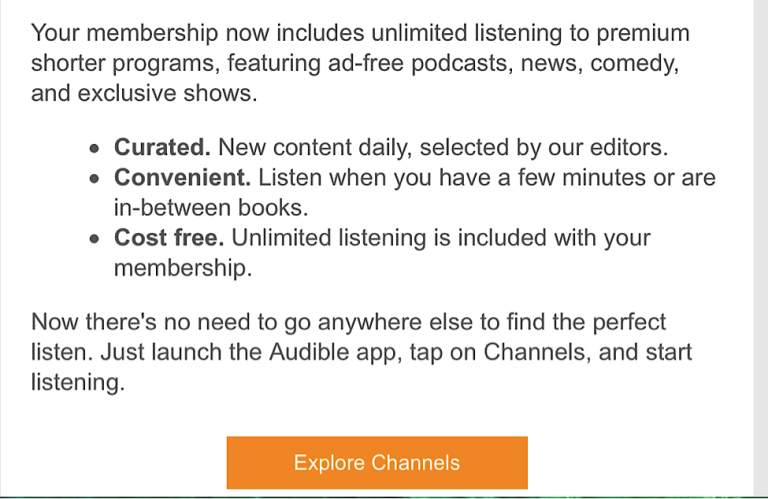
Caption: Explaining the details of a member’s plan can help increase engagement and retention, as Audible does here.
3. Bounce Rate
The bounce rate is the number of your total e-mails sent that could not be delivered to the recipient’s inbox. This happens when there is a problem with the e-mail address; those that are unopened or reported as spam are not included in the bounce rate metric.
There are two types of bounces—hard bounces and soft bounces.
Soft bounces are temporary problems that sometimes happen with a valid e-mail address, like having an inbox that’s full and needs to be emptied, or a malfunctioning server. These aren’t anything to be concerned about.
Hard bounces are another story, and are permanent problems; they include invalid/fake e-mail addresses, or closed e-mail accounts. Since hard bounces are permanent problems, remove those users from your list as soon as you notice the pattern; ISPs use bounce rates as part of their evaluation when looking at an e-mail sender’s reputation, so you don’t want a high bounce rate to damage yours.
How to reduce your bounce rate
While soft bounce rates aren’t anything to be too concerned about (you can always resend the e-mail later), hard bounces aren’t good for your sender reputation, and can often cost you money if you keep them on your e-mail list.
Some tips to help reduce your bounce rate include:
- Monitor your e-mail list for users who have consistently been hard bounces and remove them from your list immediately
- Make it easy for users to update their e-mail address on your site if they change it
- Have a welcome e-mail series, where users are asked to confirm their subscription, to ensure that only valid e-mail addresses make it onto your list
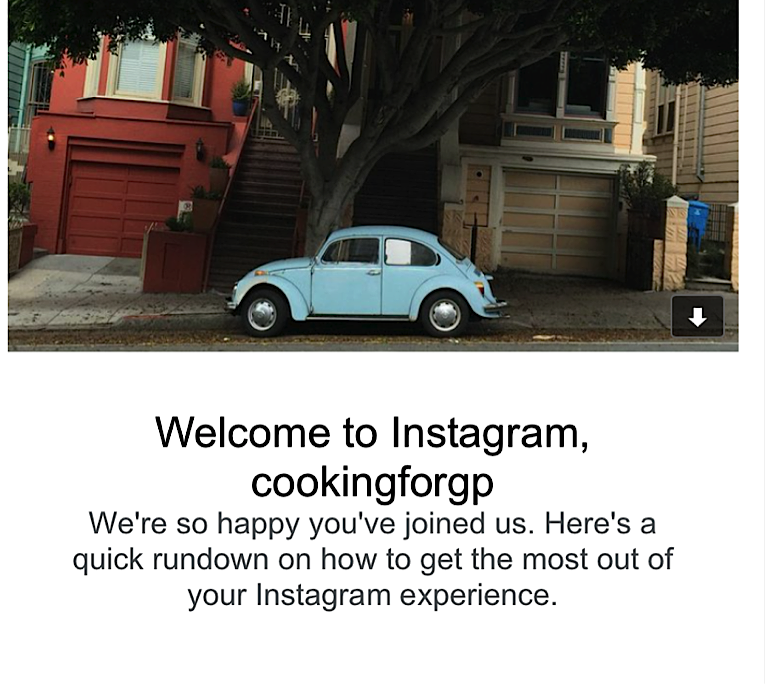 Caption: Welcome e-mails that require verification to confirm subscription can reduce bounce rates by eliminating fake or invalid addresses early on.
Caption: Welcome e-mails that require verification to confirm subscription can reduce bounce rates by eliminating fake or invalid addresses early on.
4. Unsubscribe & Spam Rate
Your unsubscribe and spam rates are two separate metrics, but they’re similar, so we’re lumping them together into this category. Your unsubscribe rate will tell you how many users have unsubscribed and the spam rate, unsurprisingly, will tell you how many users have sent your e-mails to their spam folder. Sometimes people will do both—G-mail has a feature allowing users to do this.
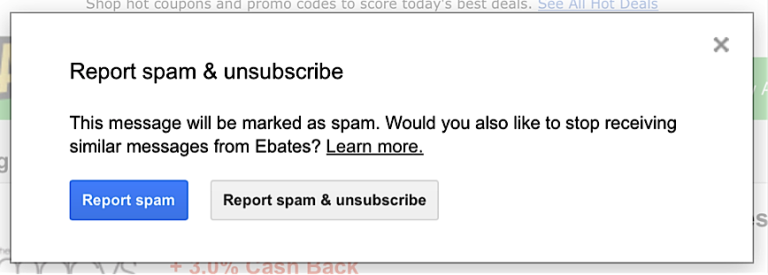
Caption: G-mail allows users to report an e-mail as spam and unsubscribe from the list with one click of the mouse.
While it’s normal to have users unsubscribe, you want to make sure that certain campaigns aren’t driving users away in droves—if you are, it’s time to take a look at what’s causing it. You want to make sure that your spam and complaint rates stay under 0.1%.
How to reduce your unsubscribe and spam rates
It makes sense why you’d want to reduce your unsubscribe rates and—most importantly—your spam rates. To help reduce these metrics, you can:
- Offer value in all of your e-mails
- Segment your list to keep relevant content going to the right users
- Allow users to choose how often they want to hear from you; giving people control over frequency can keep them on your list instead of sending them away
- Make sure your e-mails load efficiently; slow loading e-mails can kill subscription numbers. And with 53% of e-mails being opened on mobile devices, make sure your images are optimized for mobile loading.
5. Sharing Rate
Your sharing rate will tell you how often the recipients of the e-mail forward it to someone else. This metric can also include when users click a social share button within the e-mail to share it on social media sites like Facebook or Twitter. It’s evaluated by dividing the total number of forwards and/or shares by the total number of e-mails delivered (again, not the total number of e-mails opened).
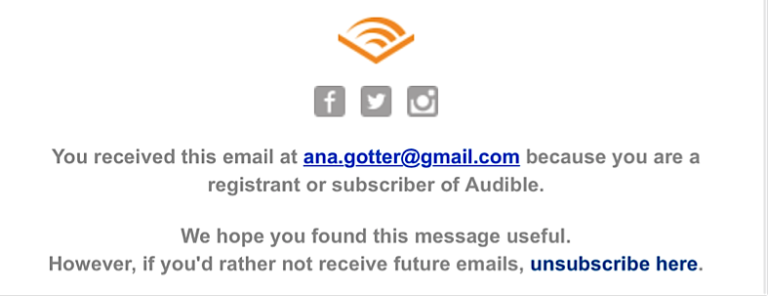
Caption: Including social sharing buttons can help increase your followers on social media platforms, as well as increase forwards and shares of the e-mail.
This metric is important not only because it shows high engagement and perceived high value from the users on your list, but also because it’s a referral. Referrals are one of the best and most reliable ways to gain new high-value, relevant clients and new subscribers for your e-mail list. This metric can help see how your e-mail campaigns are contributing to your referrals, which is hugely important.
How to increase your sharing rate
To increase your sharing and/or forwarding rate, there are several steps you can take:
- Offer referral incentive programs via e-mail
 Caption: Fabletics advertises referral incentive programs with every e-mail.
Caption: Fabletics advertises referral incentive programs with every e-mail.
- Place social sharing buttons on all your e-mails
- Increase personalization; an article on Marketing Land revealed that the more personalized an e-mail was, the more likely that user was to forward it to others
6. ROI per Campaign
Your ROI (or return on investment) tells you the bottom line—how much growth profit you made. Watching your ROI per campaign can help you determine not only whether what you’re spending is financially worth it, but also how much gain you’re getting per campaign.
To most businesses, this is what matters most, so it only makes sense that it would be a hugely important metric to watch. This is determined by your total profit per campaign divided by your total spend per campaign.
Evaluating your ROI per campaign can help you identify which campaigns are performing best, providing plenty of information to learn from and giving you the tools you need to create even strong email campaigns in the future.
While ROI per campaign can help you identify your strongest and most profitable campaigns, keeping an eye on your overall ROI can also help you see the bigger picture of your total ROI from all campaigns.
How to increase your ROI
To increase your ROI in your e-mail campaigns, try implementing these strategies:
- Be as personable as possible, and have segmented e-mail lists based on purchase history and interests
- Provide value and create urgency to inspire conversions and sales
- Schedule e-mails at peak times to increase conversions as soon as possible within a campaign series
- Keep the cost of your e-mail delivery as low as possible
7. E-mail List Growth
While everyone wants to have a large e-mail list, your e-mail list growth rate is going to be more telling (and more important long term) than the size of the list alone. The list growth rate will show you the direction your list is going in for the future. This metric is found by dividing your number of new subscribers by the number of your unsubscribes.
If you have 100 subscribers on your e-mail list today, it’s almost certain that all 100 won’t remain at the end of the year; decreases in your e-mail list is common and expected. Because of this, you want to keep an eye on your growth rate to make sure that your number of new subscribers outweighs your losses.
How to increase your list growth rate
To increase your list growth rate, there are a few things you can do:
- Continue to offer loyalty benefits and advantages for subscribers to keep your retention rate higher
- Encourage users to sign up for your e-mail list on your site in a clear, easy-to-see location
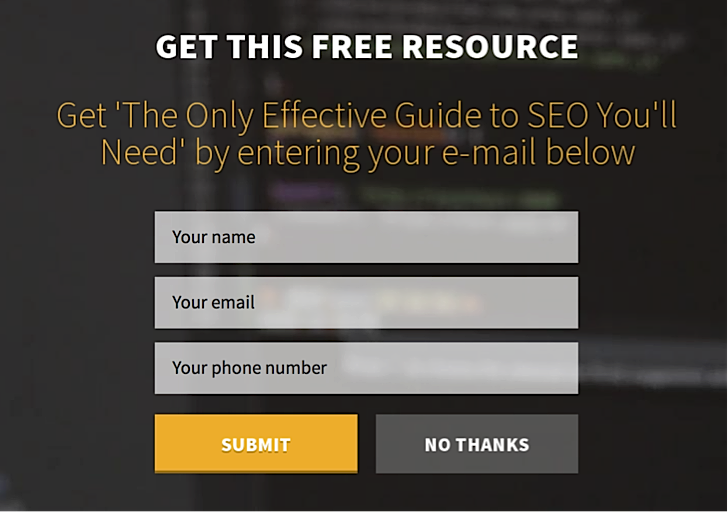
Caption: Single Grain has a landing page that encourages e-mail sign-ups by offering a free resource in exchange.
- Offer benefits to signing up for your e-mail list, like a free downloadable lead magnet or a new-subscriber discount or consultation
Final Thoughts
E-mail campaigns should be an essential part of marketing for most businesses, whether they’re purely e-commerce businesses, brick-and-mortar stores, or a combination of both. Like most aspects of marketing, knowing which metrics to casually watch and which ones to focus on can help to increase the success of the campaigns both immediately and long term.
These 7 metrics are the most important when looking at increasing sales, client actions, and ROI campaign.
What do you think? Which metrics do you value most when evaluating your e-mail campaigns? Which do you ignore? Share your thoughts, experience, and knowledge in the comments below and let us know what you think!



